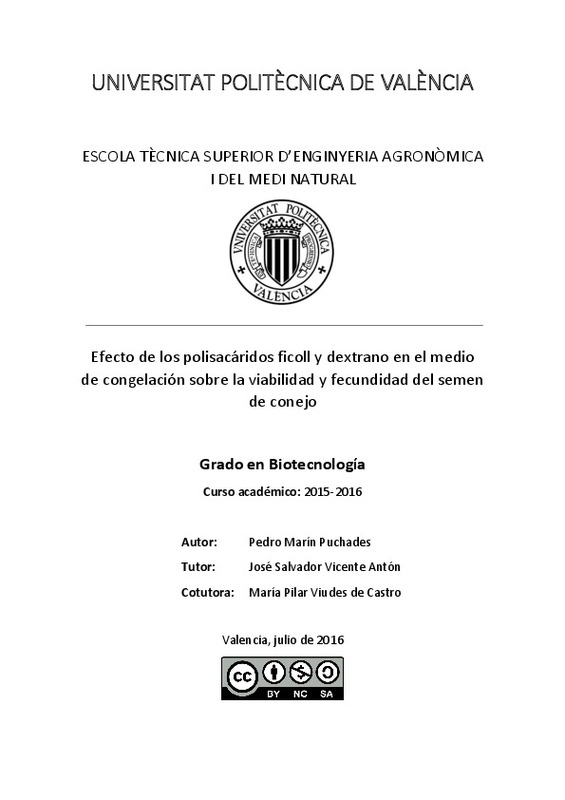|
Resumen:
|
[ES] El desarrollo de los métodos de congelación de semen en el conejo se inició en los años 60, quedando tempranamente descartado el glicerol, habitual en otras especies, como crioprotector. Actualmente, los medios ...[+]
[ES] El desarrollo de los métodos de congelación de semen en el conejo se inició en los años 60, quedando tempranamente descartado el glicerol, habitual en otras especies, como crioprotector. Actualmente, los medios utilizados para congelar semen de conejo incluyen como crioprotectores la acetamida o el dimetil sulfóxido y en muchos casos yema de huevo o un disacarido (sacarosa o trealosa). Sin embargo, la posibilidad de inseminar con semen congelado con fines productivos es todavía hoy descartable a consecuencia de sus resultados. ya que sus tasa de fertilidad y prolificidad generalmente son variables y menores que con semen refrigerado.
En los últimos años que la incorporación de polisacaridos como el dextrano o el ficoll, compuestos no permeables de gran peso molecular, reducen tanto los daños por la formación de cristales intra y extracelulares como el estrés osmótico derivados de los medios de crioconservación protegiendo la membrana celular durante el proceso de enfriamiento y congelación.
Por ello, el objetivo del presente trabajo es estudiar la utilzación de ficoll o dextrano en un diluyente de congelación espermática de conejo y evaluar cómo afectan tanto a la preservación de las membranas espermáticas (plasmática y acrosomal) como a la movilidad y fecundidad de los espermatozoides. El trabajo se realizará en dos fases. La primera se ensayarán in vitro 8 medios de congelación espermática con 2 niveles de concentración ficoll y dextrano (4 y 6% peso/volumen) y 2 concentraciones de sacarosa (0,1M y 0,05M). Sobre todos ellos se valorarán la viabilidad y daños espermáticos post-descongelación a nivel de membrana plasmática y acrosomal, registrando y analizando los parámetros de movimiento del semen. En la segunda fase, atendiendo a las resultados in vitro se seleccionarán los dos medios con mejores parámetros espermáticos post-descongelación se evaluará frente a un grupo control (semen no congelado) la fecundidad de los espermatozoides congelados. Para elllo, se inseminarán 30-40 conejas por grupo experimental evaluando el porcentaje de conejas gestantes, paridas así como sus tamaños de camada al nacimiento.
[-]
[EN] The mediums used to freeze rabbit sperm include acetamide, dimethylsulfoxide and, in many cases, egg yolk or a disaccharide (sucrose or trehalose) as cryoprotectants. Nowadays, the possibility of inseminate with frozen ...[+]
[EN] The mediums used to freeze rabbit sperm include acetamide, dimethylsulfoxide and, in many cases, egg yolk or a disaccharide (sucrose or trehalose) as cryoprotectants. Nowadays, the possibility of inseminate with frozen semen for productive purposes is still ruled out because their lower and variable rates of fertility and prolificacy. In recent years, have been studied the incorporation of polysaccharide, such as dextran or ficoll, to the cryopreservation medium. These compounds are able to reduce damage due to the formation of intra and extracellular crystals as osmotic stress derivatives of cryopreservation medium. Therefore, the objective of this study is to evaluate the application of ficoll and dextran in the medium of rabbit sperm cryopreservation and check how they affect to the preservation of sperm membranes (plasmatic and acrosome), motility and fertility.
The study was conducted in two experimental phases. In the first, 8 mediums of sperm cryopreservation were performed. These mediums differed in their initial ficoll and dextran concentration levels (4 and 6% weight / volume) and sucrose concentration (0.05M 0.1M and) and were evaluated against a standard cryopreservation medium without polysaccharide and 0.1 M sucrose. For each (9) were evaluated the percentage of sperm post-thaw with not damage at plasma and acrosomal membrane level and kinetic parameters of sperm. In the second phase, based on the results obtained in vitro and limitations of the study in vivo, two mediums and two freezing protocols, which differed in the rate of freezing, were tested, analysing the fertility and prolificacy versus a control group (not frozen sperm).
Post-thaw analysis do not show significance of the polysaccharide in the medium for any of the parameters evaluated. However, an effect of sucrose concentration was observed in the medium, being lower post-thaw damage at plasmatic and acrosomal membrane level, when the sucrose concentration in the medium was 0.1 M. In the second experimental phase, the results of in vivo analysis of the selected mediums (standard cryopreservation medium and a medium with dextran at 6% weight / volume and 0.1M sucrose) showed a differential response of the medium according to the cryopreservation protocol used. Similar fertility rates to the fresh control for standard medium with the programmable freezing protocol were obtained and similar prolificity to the fresh control for standard medium with the freezing box protocol. However, taking into account both production parameters, the post-thawed sperm not allowed to obtain competitive results with the fresh control. Thus, based on the results obtained, it can be concluded that the addition of ficoll or dextran polymer (mw 70,000) at levels of 4 and 6 % (weight/volume) to a standard medium does not improve in vitro and in vivo results.
[-]
|







